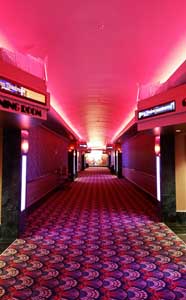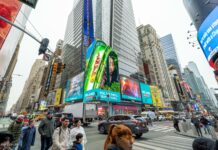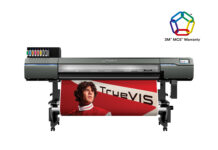“LEDs are helping expand the type of form factors you can put lights into,” says J. Bryan Vincent, managing partner at Principal LED. “With some of the newer products, it’s possible to get lights into smaller, lower profile coves where it might be difficult to put in neon or fluorescent lighting.”
Flexible LED tapes and tubing especially are creating new applications for illuminating highlights and accents—indoors and out. “These components are cuttable, bendable, and so flexible that they can be used for many different types of projects,” says Mike Bluhm, North American sales manager for SloanLED.
Part of the appeal of the LED stripes, notes Bluhm, is that the colors of the tubing are bright enough to draw attention to a sign even during daylight hours.
Diverse Opportunities
“LEDs are making it possible for every sign shop, even small mom-and-pop shops, to get into the electrical sign business,” says Jeff Fassett, president of Aries Graphics. “And LEDs are becoming really diverse, with a greater range of potential applications.
“LED tubing is looking and performing more like neon every day.”
Vincent says more customers are exploring the use of LED products for outdoor projects. “They’re being used to illuminate the wall or highlight specific elements of a building, monument, or sign,” he says.
“To make sure LED lighting stands out in various border design applications, it’s important to be fully cognizant of the environment the LED strips/tubes will be used,” says Joey Shimm, marketing director for Outwater Plastics Industries, Inc. “For instance, if intended for outdoor use, it is imperative that the LED strips/tubes be rated accordingly to assure the utmost safety to both the user and the structure to which it is being affixed.
“This entails that the LEDs be impervious to adverse weather conditions and other factors—including exposure to water, salt water, temperature extremes, and direct sunlight for prolonged periods of time.”
Border lighting LED components are offered in 12V, 24V, and 120V products, so it’s important to establish the voltage that best suits the parameters of the application.
According to Shimm, 120V lighting is ideal for use in tasks in which much longer runs of lighting are required (due to lower voltage LEDs requiring supplemental power supplies over finite distances), but they’re not intended for on-the-ground use and can present a shock hazard in certain situations, if accidentally cut. “However any of the three voltages can be employed in indoor or outdoor applications as desired,” says Shimm.
And keep in mind smaller shop owners who handle the occasional LED project or aren’t interested in bringing design and fabrication in-house can turn to LED vendors. Today project design and consultation are a standard part of services by those who cater to the sign industry, making for an easier entry into LED products and solutions.

Design Considerations
When evaluating LED products as a solution for accent or highlights, several factors must be taken into account.
“First you have to think about the space you’re working with. [See] if there are any size constraints,” says Vincent. “Then look at the amount of area you want to illuminate, as well as the effect you’re trying to achieve. Those can impact both the type of LED and the required beam angle.”
Since LED tubes are more directional than neon and don’t light evenly in all directions, care must be taken if you want to achieve a halo/glow effect on the building or substrate. “LEDs are very well diffused though, so you only need to stand them off one to two inches,” says Fassett. “But watch out for shadows; also avoid shiny or reflective surfaces, as those often don’t give the desired effect.”
Fassett points out that LED tubes also have different bend angles relative to the primary direction of the light. “Some bend in all directions,” he says, “but most are designed to either bend around a corner or bend flat against the substrate.”
According to Fassett, there are two additional design restrictions that you have to keep in mind when working with LED tubes: bend radius limits and cut points. “You cannot make a drop bend with an LED tube like you can with glass,” he says. “You have to design with a flat bend or cut the tube on a sharp corner.
“Different tubes have different bend radii. The tubes can only be cut at certain points—maybe every couple of inches.”
According to Fassett, the ideal placement of LED tubes in border lighting applications depends in large part on the viewing distance.
For example, if you’re trying to capture attention from the highway (such as at a gas station or a movie theater), then consider placing the tubes along the top of the building or structure. “But if the viewing distance is much closer, such as from the sidewalk in front of the retail business,” he says, “then put the tube at eye level.”
Making sure the color of the border tubing matches the colors of the clients channel letters is another good idea to aid people in helping them find a business.
In fact, the choice of LED color impacts the overall aesthetics, even when the project calls for white light.
LED lighting is most often offered in three shades of white. “Cool White (6000K-6500K) is equivalent to noon sunlight with a slight bluish hue,” says Shimm. “Pure White/Natural White (4000K-4500K) produces a natural, accurate, and realistic color rendering, while Warm White (2800K-3200K) generates a warm, nostalgic feeling.”
“With white, you have to think about the color temperature and the effect you’re trying to achieve,” says Vincent. “Accent lighting typically leans toward a warmer light, while illuminating a sign might call for a colder white.”
The choice of colors in LED border tubing can also be effectively employed when the client wants special effects.

“Some want to see a blue or a red during the day, and the color of LED border tubing can be used to achieve that,” says Bluhm. “Meanwhile the brighter whites create a rainbow of possibilities. White LED strips can be wrapped with translucent vinyl to create any color they want.”
LEDs can also be used to create special effects inside venues. “Alerting your customer to that option as a way of drawing more attention to their business creates an opportunity to up-sell them from an LED strip to border tubing,” says Bluhm.
As far as other colors go, even clients who request a specific color to complement the setting should be alerted to a system of RGB LEDs as an option, where allowed. “Some clients may not be aware of the versatility of an RGB LED system and the ease with which they can change colors or create special animation effects or fades,” says Vincent.
Also consider what the sign or building will look like during the day opposed to night. “Some LED tubes are all white, irrespective of the color of the LEDs,” says Fassett, “whereas others are the color of the LEDs.
“Good contrast of complementary colors will help the tubes stand out.”
By Mike Antoniak
Photos (top to bottom): SloanLED, Principal LED, SloanLED.











